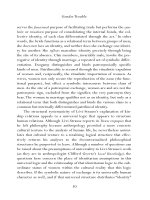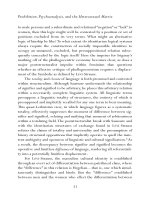GENDER TROUBLE 139
Bạn đang xem bản rút gọn của tài liệu. Xem và tải ngay bản đầy đủ của tài liệu tại đây (20.48 KB, 1 trang )
Gender Trouble
semiotic, that domain of linguistic meaning distinct from the Symbolic,
which is the maternal body manifest in poetic speech.
As early as Revolution in Poetic Language (1974), Kristeva argues for
a necessary causal relation between the heterogeneity of drives and the
plurivocal possibilities of poetic language. Differing from Lacan, she
maintains that poetic language is not predicated upon a repression of
primary drives. On the contrary, poetic language, she claims, is the linguistic occasion on which drives break apart the usual, univocal terms
of language and reveal an irrepressible heterogeneity of multiple
sounds and meanings. Kristeva thereby contests Lacan’s equation of
the Symbolic with all linguistic meaning by asserting that poetic language has its own modality of meaning which does not conform to the
requirements of univocal designation.
In this same work, she subscribes to a notion of free or uncathected energy which makes itself known in language through the poetic
function. She claims, for instance, that “in the intermingling of drives
in language . . . we shall see the economy of poetic language” and that
in this economy, “the unitary subject can no longer find his [sic]
place.”2 This poetic function is a rejective or divisive linguistic function which tends to fracture and multiply meanings; it enacts the heterogeneity of drives through the proliferation and destruction of
univocal signification. Hence, the urge toward a highly differentiated
or plurivocal set of meanings appears as the revenge of drives against
the rule of the Symbolic, which, in turn, is predicated upon their
repression. Kristeva defines the semiotic as the multiplicity of drives
manifest in language. With their insistent energy and heterogeneity,
these drives disrupt the signifying function. Thus, in this early work,
she defines the semiotic as “the signifying function . . . connected to
the modality [of] primary process.”3
In the essays that comprise Desire in Language (1977), Kristeva
ground her definition of the semiotic more fully in psychoanalytic
terms.The primary drives that the Symbolic represses and the semiotic
obliquely indicates are now understood as maternal drives, not only
104









